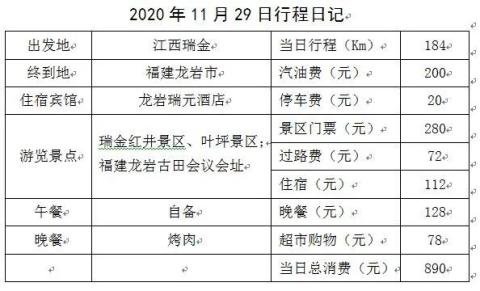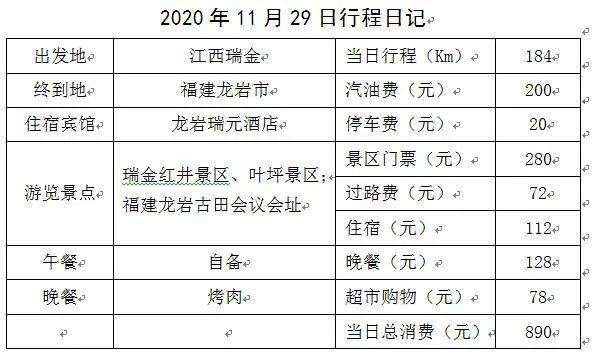
On November 29, 2020, we set off from Ruijin, Jiangxi Province at 8:50 in the morning, visited Ruijin Hongjing Scenic Area and Yeping Scenic Area, and arrived in Longyan, Fujian Province in the afternoon to visit the Gutian Conference Site. This travel note mainly introduces Ruijin Hongjing Scenic Area and Yeping Scenic Area.
1. Itinerary for the day





Shazhouba is a dry and water-scarce place. Not only is there no water to irrigate the fields, but it is also very difficult for people to drink water. Chairman Mao understood the sufferings of the masses here and proposed "care about the lives of the masses and pay attention to work methods." He personally led soldiers to fetch water for the masses and solved the drinking water problem of the villagers. He founded Lenin Primary School and solved the problem of children's education. Our primary school textbook "Don't forget to dig a well after eating" comes from here.


In September 1933, in order to solve the water difficulties of the local military and civilians, Mao Zedong led government staff and worked with the local people to dig this well. In October 1934, after the main force of the Central Red Army launched its Long March, the enemy tried to fill up the well many times. However, the people of Shazhouba persisted in fighting the enemy and finally saved it.

In 1950, the well was renovated, and the masses called it the "Red Well" and erected a monument next to the well: "Drinking water never forgets the man who dug the well, and always misses Chairman Mao" to express their respect and memory for Chairman Mao and the Red Army. .
2. Yeping Scenic Area


Ruijin Yeping Red Tourist Scenic Spot is a national key cultural relic protection unit. It is located in the old village of Yeping Township, Ruijin City, 6 kilometers away from the urban area. This is the birthplace of China’s first nationwide red regime, the Provisional Central Government of the Soviet Republic of China. It is also the first residence of the Provisional Central Government of the Soviet Republic and the highest leading organ of the Soviet Area of the Party Central Committee – the Central Bureau of the Soviet Area of the Communist Party of China, in China. A glorious page was written in the history of revolution. This is where the title Chairman Mao came from. A large number of proletarian revolutionaries of the older generation, including Mao Zedong, Zhou Enlai, Zhu De, Ren Bishi, etc., all lived and worked in Yeping. After the Red Army's Long March, these buildings were demolished by the Kuomintang Ruijin authorities. After the founding of New China, destroyed buildings were rebuilt and damaged revolutionary sites were renovated.


In 1959, the state allocated special funds to build Yeping New Village, moved the old villagers to live in the new village, and built walls around the old village to form a key cultural relics protection zone in Yeping, open to the outside world. The old site group preserves the original appearance of the Soviet area period to the greatest extent. From the mid-to-late 1990s to the present, more than a dozen national ministries, commissions, offices, and bureaus have come to trace their roots and ancestors, repair the old sites, and establish the revolutionary tradition of this system Education and patriotism education base. In order to enrich tourists' sightseeing projects, the former site group performs red song and dance programs regularly every day, and has participatory activities such as wearing red military uniforms and learning to make bamboo handicrafts.
3. Talk about understanding of Jiangxi Province
The ancients said, "Read thousands of books and travel thousands of miles." The trip to Jinggangshan in September 2020 and this red trip to southern Jiangxi gave me a better understanding of the geographical and cultural environment of the old revolutionary areas in Jiangxi.

Jiangxi Province, referred to as Gan (gàn), is the "hometown of rice" in the south of the Yangtze River. In ancient times, it was known as "the head of Wu and the tail of Chu, and the people of Guangdong and Fujian". The province got its name from the Jiangnan West Road established by Emperor Xuanzong of the Tang Dynasty in 733 AD. It was also shortened to Gan because the largest river in the province was the Ganjiang River. Jiangxi Province borders Zhejiang Province and Fujian Province to the east, Guangdong Province to the south, Hunan Province to the west, Hubei Province and Anhui Province to the north and both share the Yangtze River. It belongs to the East China region, and the provincial capital is Nanchang City.
Except for the relatively flat northern part of the province, the east, west and south are surrounded by mountains on three sides, and the central part is hilly, forming a huge basin that slopes toward Poyang Lake and opens to the north. There are more than 2,400 large and small rivers in the whole territory. Ganjiang River, Fuhe River, Xinjiang River, Xiuhe River and Raohe River are the five major rivers in Jiangxi. Poyang Lake is the largest freshwater lake in China. Jiangxi is located near the Tropic of Cancer. The province has a warm climate and abundant rainfall, with an average annual precipitation of 1341 mm to 1940 mm. It has a long frost-free period and a humid subtropical climate.
I met a colleague from Jiangxi who likes chili and hot pot, and I found the reason this time.
In Ruijin, we purchased some navel oranges, a local fruit with thin skin and pure sweetness. We experienced the quality of the "Gannan Navel Orange" brand, which is worthy of being the best in the navel orange family! Jingdezhen's porcelain industry has a long history, and its products are famous both at home and abroad. On the way back, we made a special trip to Jingdezhen City to visit the "Chinese Porcelain Museum". Next, there will be a special travelogue of "Chinese Porcelain Museum".
